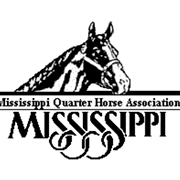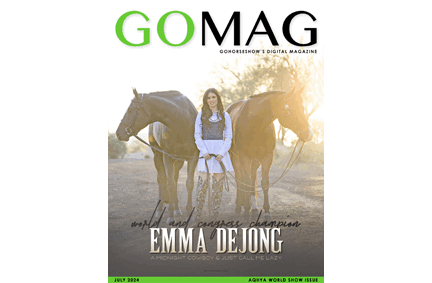One of the most exciting aspects of showing horses is that everyone can find their niche due to the vast variety of classes. This diversity also allows riders the flexibility to change course if they find themselves getting bored or frustrated in their current discipline – or if they simply want to expand their horizons.
However, that variety can also be a bit daunting as each discipline has its own rules, standards, and idiosyncrasies. In this two-part series, we will speak to top trainers about their tips for changing disciplines from Western to English and English to Western.
In Part 1, we spoke with World and Congress Champion Hunt Seat trainer Keith Miller of Miller Quarter Horses to get his tips for how to adjust and succeed in the English world after showing predominantly in Western events.
Know the Rules and Expectations
“I strongly believe that the first step in finding success in any new discipline is to read the rules,” Miller emphasizes. “It’s amazing to me how many people don’t know the rules and the scoring systems when they start a new class, which puts them at a serious disadvantage.”
“We had a student who was very strong in the horsemanship that decided to add the equitation to her classes. She went into the ring and laid down what she believed to be a perfect pattern, and, had it been horsemanship, it would have been fantastic,” he chuckles.
“Unfortunately, she didn’t have the proper position in her arms and legs, so what was the ideal position in the horsemanship was below average in the equitation. For as much as there are similarities, there are also key differences.”
Miller points out that reading the rules and learning these differences sets you up to actually understand the classes, which will give you an advantage in your practices and performance.
He notes, “I think one of the most important differences between Western and English is the desired body position of the rider and movement of the horse.”
“The judges want to see the horses presented in front of your leg, moving both forward and through in their stride. A lot of the Western horses are heavily spur trained, so if the rider tightens their legs, they suck back, which makes them move behind the leg.”
Miller reminds us, “I think the most common mistake Western riders make when coming to English is presenting a posting jog and a slightly faster lope. Western horses can have success in English disciplines, but only if you present them like an English horse. You must show a true trot and a real canter.”
Observe the Classes
“I really think riders today are at a huge advantage when it comes to being able to observe what wins and make efforts to emulate that.”
Miller recalls, “I grew up in a world where we didn’t have money for lessons and I showed open shows where I had to learn a lot through trial and error. I couldn’t go to the major breed shows and watch what was winning.”
“Now, there are tons of videos available of winning goes and judges breaking down rides and explaining what they are looking for. You don’t have to travel across the country or pay for a clinic to absorb this information,” Miller encourages.
“Horses are expensive, but paying attention is free!” he exclaims. “Watch the classes. Note what wins and what doesn’t. Observe the attire, how the horse is turned out, and how they move. You and your horse are unique, but do your best to align with the standard in order to set yourself up for success.”
Practice in the Tack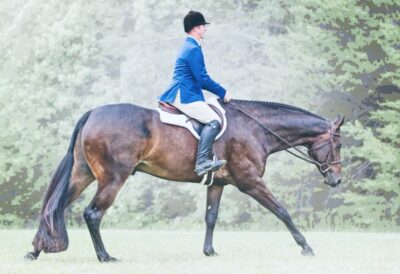 “I’ve noticed that Western riders really love the comfort of their Western saddles,” Miller laughs. “English saddles can leave you feeling more…exposed.”
“I’ve noticed that Western riders really love the comfort of their Western saddles,” Miller laughs. “English saddles can leave you feeling more…exposed.”
“If you are uncomfortable riding in English tack, it is even more important that you get comfortable with it,” he chides. “And the only way to do that is to ride in your English saddle and wear your English boots.”
“You won’t magically become more comfortable at a show – in fact, it tends to have the opposite effect. If you want to show the English, you need to practice riding English the way you would show it.”
Physical Fitness is Important
Miller believes that riding English and Western both require a certain degree of fitness. While Western requires a strong core and legs in order to hold still in the saddle, English allows for more movement, which brings a cardio element into play.
“I have seen the judges make exhibitors trot into the ring and trot multiple times around the arena before they even begin judging you,” he inhales sharply. “Then, they make you trot 4-5 laps and go right into the canter for another 4-5 laps. In a word…it’s exhausting!”
“Posting the trot for multiple laps in and of itself is a real cardio workout, so I advise my clients to spend time outside of the arena working on cardio – go to the gym, go on hikes, ride a Peloton,” Miller recommends.
“The horses are athletes and, in many ways, you also need to be an athlete to keep up with them. I probably ride around ten horses a day, I also go to the gym multiple times a week, and I ride the Peloton to stay fit in order to be competitive,” he laughs. “These skinny minnies are tough to keep up with.”
Put Your Best Foot Forward
Miller admits, “So much of showing is about presenting a certain picture. Western has an ideal overall picture and so does English. Make sure you are prepared to show yourself in alignment with that ideal presentation – especially when starting out.”
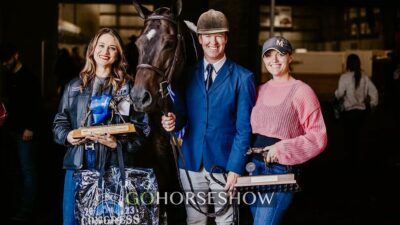 He explains, “I’m very much a traditionalist and the English discipline tends to favor that traditionalism. I prefer the standard colors and styles, especially for novice riders. While subtle differences are fun, it is important to remember there is always a subjective element to the classes and I hate to see people put themselves in a position where they stand out for the wrong reasons.”
He explains, “I’m very much a traditionalist and the English discipline tends to favor that traditionalism. I prefer the standard colors and styles, especially for novice riders. While subtle differences are fun, it is important to remember there is always a subjective element to the classes and I hate to see people put themselves in a position where they stand out for the wrong reasons.”
Miller reminds us, “The English rules actually have penalties for inappropriate attire. For example, burgundy and red coats are specifically called out to be penalized. It is such a simple thing to follow and I hate to see good goes marred by these avoidable errors.”
“One of the things I really love about English is that there is less pressure to show in a super expensive outfit. A nicely fitted hunt coat and used saddles are so much more cost-effective for people on a budget. If you have a good fit and flattering, traditional colors, it’s hard to go wrong in attire.”
Finally, Miller says that a “good look” goes beyond the rider. “It is also important to show your horse at their best. Make sure they are brushed, bathed, clipped, in good body condition, and braided appropriately for the class.”
Learn Your Diagonals and Two-Point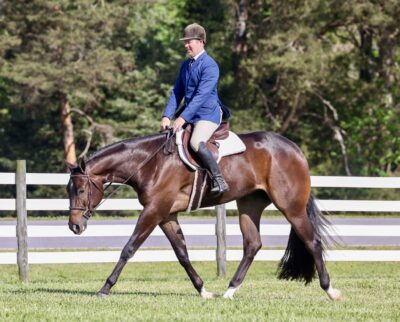 “One of the main skills to riding English classes is being able to post properly. This is a huge priority for the Association as well.” Miller highlights, “According to the rule book, if you look for your diagonal in an equitation class, you are penalized more than if you get the wrong diagonal and quickly change it. Picking up the proper diagonal based on feel is critical.”
“One of the main skills to riding English classes is being able to post properly. This is a huge priority for the Association as well.” Miller highlights, “According to the rule book, if you look for your diagonal in an equitation class, you are penalized more than if you get the wrong diagonal and quickly change it. Picking up the proper diagonal based on feel is critical.”
“Additionally, riders need to learn how to perform a proper two-point,” he emphasizes. “I see a lot of riders just stand up in the stirrups. This is incorrect.”
“To properly two-point, a rider will need to drop their heels, shorten their reins, and rise up and forward over the horse’s withers. If you simply stand up in the saddle, you aren’t helping your horse get over a jump, you’re probably making it harder for them.”
“It is a pet peeve of mine when riders two-point for the hand gallop before lengthening the stride,” he admits. “You must first lengthen the stride, and then go into the two-point. It isn’t enough to just fulfill the position and canter in two-point…you must also fulfill the gait.”
Don’t Mistake Speed for Correctness
Finally, Miller reminds us that many riders coming from Western to English seem fixated on speed because Hunter Under Saddle naturally covers a lot more ground than Western Pleasure.
“If you focus on speed, you’re likely missing the point,” he laughs. “The key to proper movement is to lengthen and lift the stride. You want the horse to move ‘through’ the stride – extending to the length of their limbs. A longer stride will naturally be faster in speed because you are covering more ground in a step, but speed and ‘quickness’ are two different things. Don’t be quick! Instead be long, steady, and precise.”




